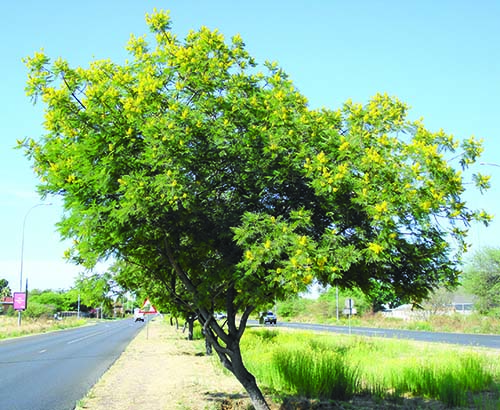THIS tree is very conspicuous from October to December when covered in very showy, bright yellow flower sprays, which may reach a length of 15cm.
The leaves are somewhat similar to those of a jacaranda but not as big. Young twigs, growth tips, leaf and flower stalks are covered with soft reddish brown hairs.
True wattle trees with similarly feathery leaves originate from Australia. The weeping wattle (P. africanum) in South Africa is apparently attacked by an insect, which sucks its sap and then exudes a fluid that drips from the tree like tears or rain drops. This insect does not occur in Namibia and therefore African wattles in our country do not weep.
Names: A huilboom, means ‘weeping tree’; H & G omuparara; (Nd & Ky) omupalala. The botanical name Peltophorum is derived from the Greek word for ‘shield-bearing’ and may refer to either the flat shield-like shape of the pods or to the shape of the stigma.
This fairly common tree occurs from the Waterberg northwards as far as the Kunene and the Okavango rivers. In Windhoek it can be seen between the lanes of Mandume Ndemufayo Ave between Academia and Pionierspark and is quite common in the road reserve of the B1 south of Otavi.
It is a small to medium sized tree with a spreading crown, often branching from near the ground or with two to three stems arising from ground level and reaches a height of up to 12m.
The dark brown bark of old trees is rough with lengthwise fissures but smooth and grey on young trees and branches. Young shoots are densely covered with velvety rust coloured hairs.
The leaves are divided like those of the acacias but much larger.
The flowers, growing in very showy, bright yellow, erect sprays are unmistakeable. Individual flowers can become 2 cm in diameter and have crinkly petals. Flat pods, pointed at both ends, dark brown when ripe, are found on the trees in dense clusters from February onwards.
Uses: Bark and roots are used to treat stomach disorders. The Herero and Himba people sprinkle an extract of the bark over everybody present at the birth of twins, including the mother and the babies, to protect them from harm. In Owambo culture the branches are used to build kraals and to support the large butter calabashes. Cups, buckets and tool handles are carved from the wood. Parts of the tree, ground up and mixed with water are applied to the hides of domestic animals to fend off certain flies, while the dried roots may be used to poison food.
Young leaves and pods are relished by cattle and goats and twigs and leaves are eaten by elephant, black rhino, giraffe, kudu, impala and grey duiker. The flowers provide a good quality nectar and pollen for bees.
Propagation: The African wattle makes a beautiful garden tree. Seedlings are available from forestry nurseries and from the nursery of the National Botanical Research Institute, Contact No 061 202 2014.
The African wattle is protected by forestry legislation.
Stay informed with The Namibian – your source for credible journalism. Get in-depth reporting and opinions for
only N$85 a month. Invest in journalism, invest in democracy –
Subscribe Now!






